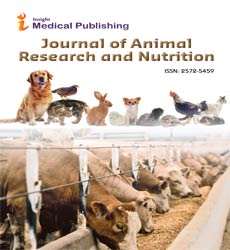Nematode Parasite Load and Growth in Scottish Blackface Sheep
Madhu
DOI10.36648/2572-5459.21.6.91
Madhu
Department of Zoology and Environmental Sciences, Punjab University, Punjab, India
Corresponding Author:- Department of Zoology and Environmental Sciences, Punjab University, Punjab, India
Email:- madhu@gmail.com
Received: April 22, 2021, Accepted: April 28, 2021, Published: May 15, 2021
In addition to the lack of antagonism between resistance to parasitic infection and productivity (LWT) found in the present study, we emphasize on the clear favourable (negative) genetic correlation between DAG and LWT. DAG is an indicator of diarrhoea, which in young lambs is assumed to be caused by GI parasites. The significance of dag scores associated with increased risk of flystrike was highlighted by Greeff et al. (2014). That study estimated the heritability of dag scores at different ages and genetic correlations with flystrike in the breech area of the sheep with a view to it being an indicator trait that could potentially be used to breed indirectly for resistance to breech strike. Although the correlations between dag and worm egg counts were not reported in that study, strong, significant genetic correlations (0.64 to 0.81) were estimated between dag and flystrike in the breech area rendering it a very useful indicator trait to breed breech strike resistant sheep in a Mediterranean environment. In the United Kingdom, farmers have to crutch (remove wool) the breech area prior to lambs being sent for slaughter to remove any faecal soiling therefore faecal soiling is a trait of economic importance [1].
While the current study found weak correlations between dag score and parasite faecal counts, they agree with those of Brown et al. (2010) which were also reported to be very low and not significantly different from zero. These conclusions suggest that selection to improve resistance to GI parasitism in sheep would not necessarily lead to a reduction in faecal soiling therefore dag score also should be included in breeding programmes. The interactions among immunological parameters and disease should be explored further as cited by Zhao et al. (2019) and indeed are currently the subject of further study with the same animal population reported in this study. In addition, in a study of New Zealand sheep, the genetic correlations between DAG and nematode egg counts have been reported to be negative at 3 months but positive at 8 months of age [2] which further complicates the messages around this issue. Genetic correlations between dag scores and faecal counts were not significant in the present study perhaps due to the low number of instances of DAG scores higher than 0 in our population, although there was a tendency for there to be a positive genetic correlation of DAG with FECS and FECN. A significant positive correlation between FEC and DAG was also reported in Romney sheep (Bisset et al., 1992) [3]. A negative correlation between DAG and LWT in this study indicates that lower DAG scores are associated with higher lamb LWT, which will have a positive impact on productivity; this was also reported. The paper examines the current state of joint plant-animal health ser-vice delivery through plant clinics in mixed farming areas,
to provide a clear understanding of farmers' needs for animal advice and the feasibility of integrating plant and animal health services. Using data from a plant doctor survey and stakeholder consultation, the paper suggests ways to investigate how agricultural support services can be more integrated across the plant, animal, and human divides to improve and livelihoods of rural communities [4].
References
- Fletcher J, Franz D, LeClerc JE. Healthy plants: necessary for a balanced ‘One Health’concept. Veterinaria Italiana. 2009 ;1;45:79-95.
- Hawkes C, Ruel M. The links between agriculture and health an intersectoral opportunity to improve the health and livelihoods of the poor. Bulletin of the World Health organization. 2006;84:984-90.
- Swanepoel FJ, Stroebel A, Moyo S. The role of livestock in developing communities: Enhancing multifunctionality. University of the Free State; 2010.
- Manlove KR, Walker JG, Craft ME, Huyvaert KP, Joseph MB, et al . “One Health” or three? Publication silos among the One Health disciplines. PLoS biology. 2016 ; 21;14:e1002448.

Open Access Journals
- Aquaculture & Veterinary Science
- Chemistry & Chemical Sciences
- Clinical Sciences
- Engineering
- General Science
- Genetics & Molecular Biology
- Health Care & Nursing
- Immunology & Microbiology
- Materials Science
- Mathematics & Physics
- Medical Sciences
- Neurology & Psychiatry
- Oncology & Cancer Science
- Pharmaceutical Sciences
